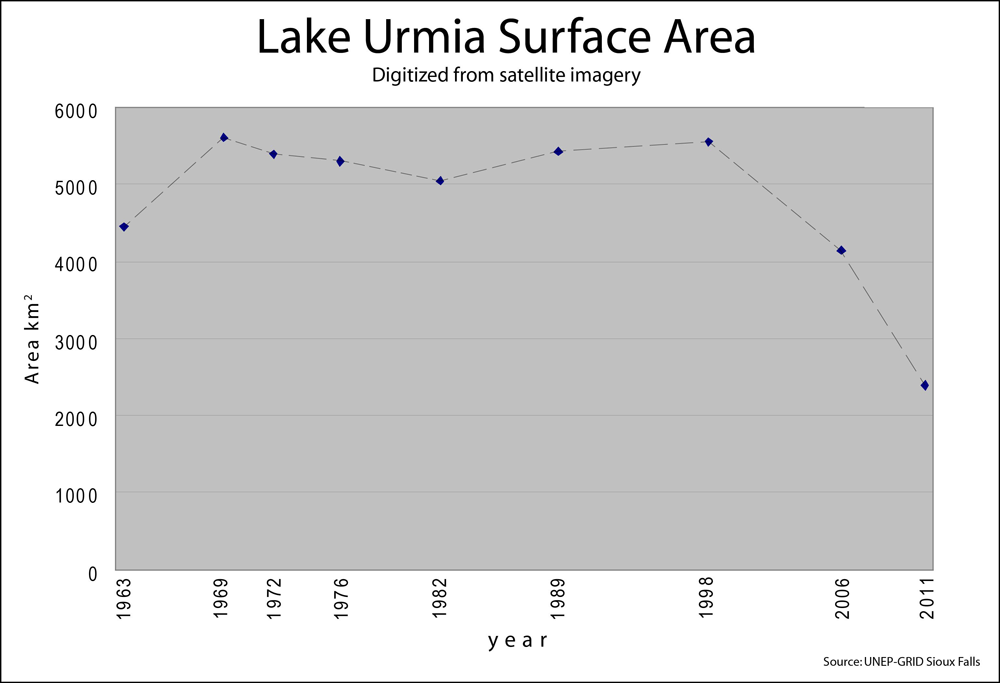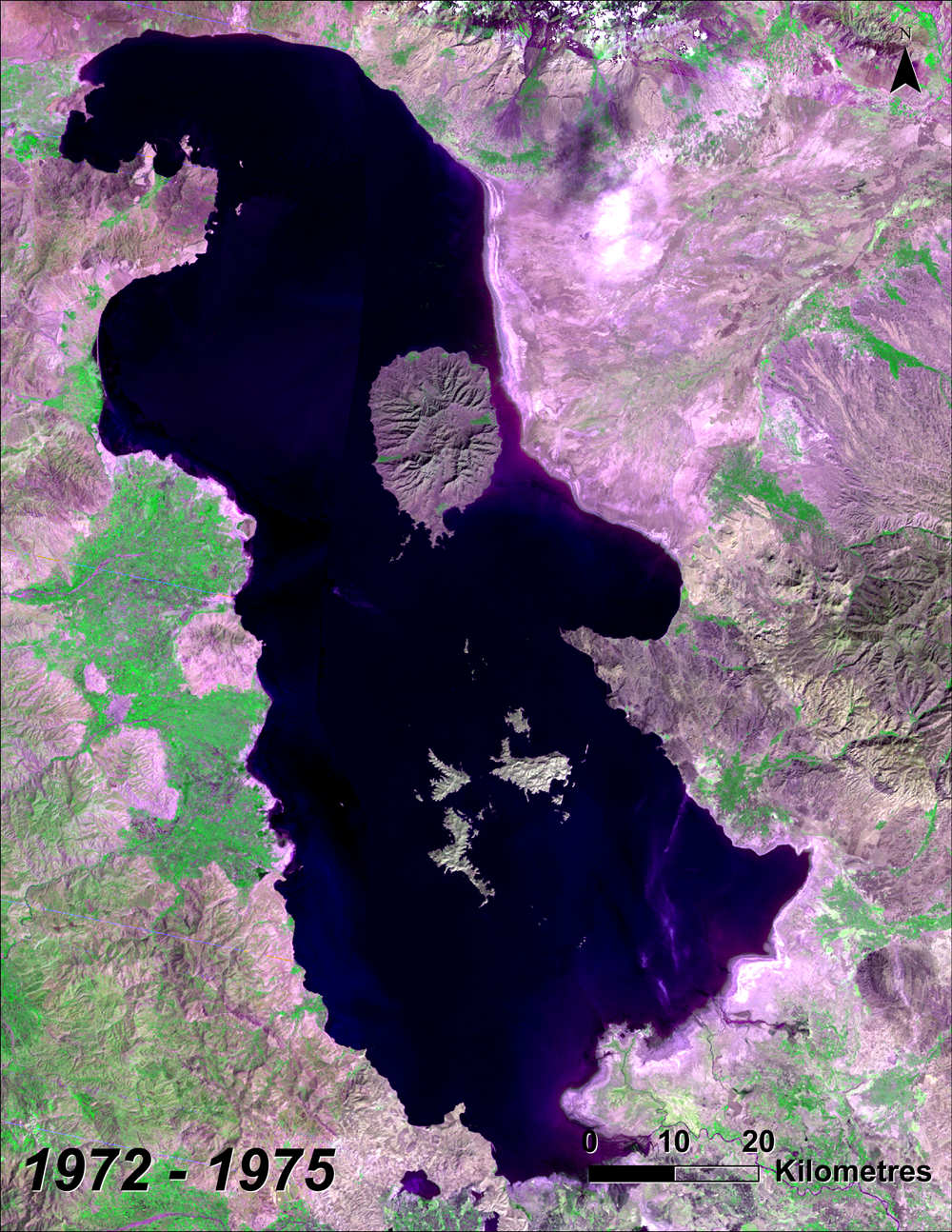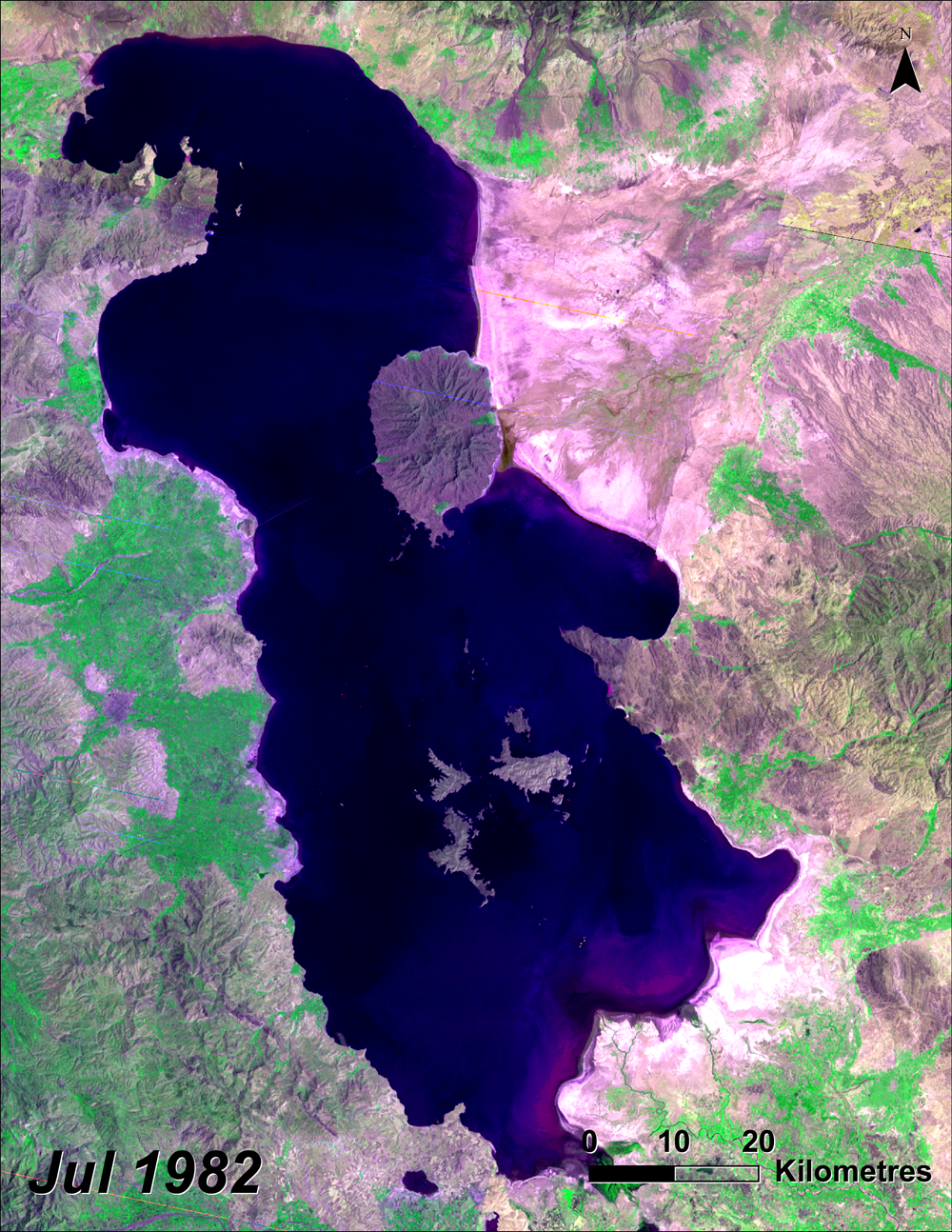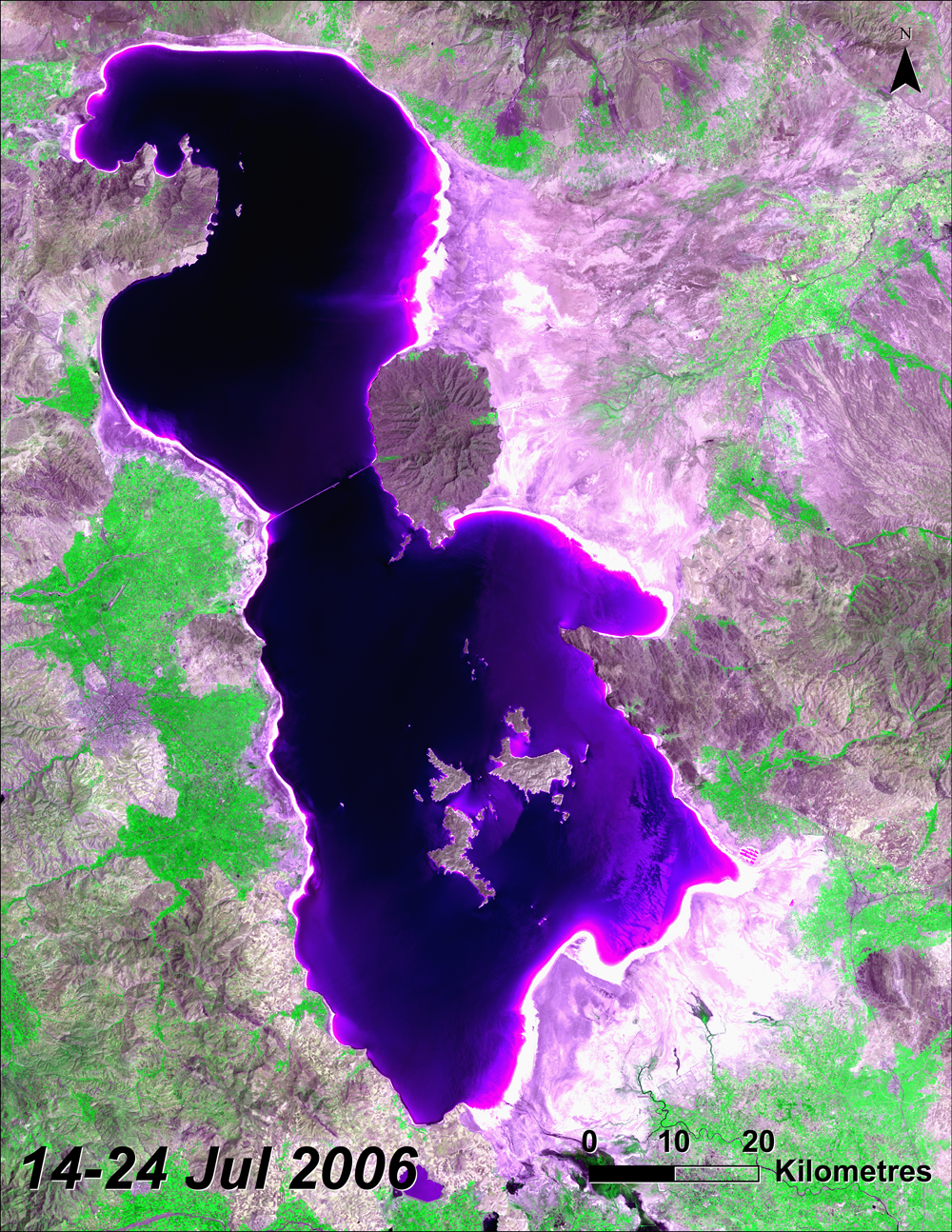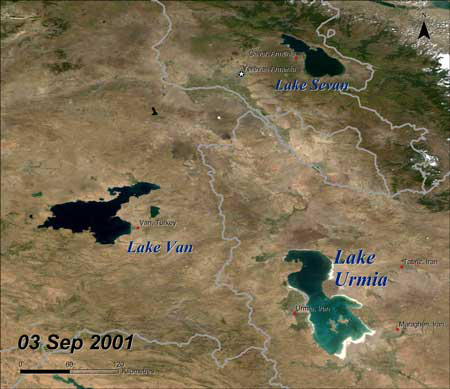The Drying of Iran's Lake Urmia and its Environmental Consequences

Lake Urmia in the northwestern corner of
Iran is one of the largest permanent hypersaline lakes in the world and
the largest lake in the Middle East (1,2,3).
It extends as much as 140 km from north to south and is as wide as 85 km east to west during high water periods (4). The lake was declared a Wetland of International
Importance by the Ramsar Convention in 1971 and designated a UNESCO Biosphere Reserve in 1976 (5,6). The lake itself is home to a unique brine shrimp species, Artemia
urmiana, and along with the surrounding wetlands and
upland habitat, it supports many species of reptiles, amphibians and
mammals. Lake Urmia provides very important
seasonal habitat for many species of migrating birds. Around
200 species of birds have been documented on and surrounding the lake
including pelicans, egrets,
ducks, and flamingos (7). The watershed of
the lake is an important agricultural region with a population of around
6.4 million people; an estimated 76 million
people live within a radius of 500 km (8).

This photo along the lake’s shoreline shows the salt left behind as the lake retreats. Photo Source: Wikipedia
The lake's surface area has been estimated to have been as large as 6 100 km² but since 1995 it has generally been declining (9)
and was estimated from satellite
data to be only 2 366 km² in August of 2011 (Landsat data).
The decline is generally blamed on a combination of drought, increased
water diversion for irrigated agriculture
within the lake's watershed and mismanagement (2,9,10,1). In addition, a causeway has been built across the lake with only a 1 500 m gap for water to move between the
northern and southern halves of the lake (9).
It has been suggested that this has decreased circulation within the
lake and altered the pattern of water chemistry;
however evidence suggests that the impact of the causeway on
the uniformity of water chemistry in the lake has been minimal (11,9,10,12).
The unfolding ecological disaster
threatens to leave much of the lake bed a salt-covered
wasteland. Scientists have warned that continued decline would lead to
increased salinity, collapse of the lake's
food chain and ecosystem, loss of wetland habitat, wind
blown "salt-storms," alteration of local climate and serious negative
impacts on local agriculture and
livelihoods as well as regional health (10,9,1,13).
Thousands of protesters took to the streets in the
cities of Tabriz and Urmia in late August and early September 2011
saying that authorities have done too little to
save the lake (14,15,16). Those around the
lake fear a fate similar to that of the population surrounding the
nearby Aral Sea, which has dried up over the past several
decades. Disappearance of the Aral Sea has been an
environmental disaster affecting people throughout the region with
windblown salt-storms. The population surrounding
Lake Urmia is much denser putting more people at risk of
impact.
A Unique Lake
Lake Urmia is an endorheic or terminal lake
meaning that water leaves the lake only by evaporation. As is generally
the case, this leads to a saltwater body and in
the case of Lake Urmia, salinity is quite high. The lake has
dramatically decreased in volume over the past decade-and-a-half,
further concentrating salts in the lake,
raising salinity to more than 300 g/L (9) or
8 times as salty as typical seawater. Aquatic biodiversity is limited
by the lake's salinity and Lake Urmia does not support any
fish or mollusk species and no plants other than
phytoplankton within the lake (17,18,19,12). Wetlands surrounding the lake support a variety of salt tolerant plant species (19).
There is significant phytoplankton growth, with reports of
some dense algae blooms occurring during years with low salinity (9). The most significant aquatic biota in the lake
is a brine shrimp species, Artemia urmiana. This
macro-zooplankton species is the key link in the lake's food chain,
consuming algae and in turn being consumed by several bird
species including the Lake's migratory flamingo population (19). The diverse bird population of Lake Urmia and its associated wetlands was documented in a series of surveys
in the 1970s which recorded an impressive list of species (7).
A Rapid Decline
Satellite altimeter data measured the lake's
level in 1995 to be at its highest level of any time in the past 40
years (Figure 1) (21,4). This is in agreement with
Hassanzadeh and others (2011) who state a measured water
level of roughly 1 278 m above sea level for the same time. Both
measures show a steady decline from that year
forward with the most recent satellite altimeter data
indicating a drop of approximately 7 metres between 1995 and 2011 (21).
Figure
1: Overlaying multiple records of the lake's surface elevation shows
generally good agreement. These data suggest that sometime around 2008,
Lake Urmia declined below any point in the past 100 years of
recorded lake levels and well below the long term average.

Figure 2: Surface area estimated from Landsat satellite imagery.
|
Because the lake is relatively shallow, this
decline in water level translates to an equally dramatic decline in
surface area (Figures 2 & 3). Satellite imagery
extending back to the early 1960s shows the lake's area to
have been somewhat smaller in 1963, growing to almost 6 000 km² in 1969,
and then remaining generally stable
from the late 1960s to the mid-1990s. Since peaking in the
mid-1990s, surface area has generally declined quite rapidly despite
regular seasonal variation and a brief
expansion during a wet period in the early 2000s.
|
Variability of the lake prior to the early
1960s does not appear to have been widely studied, however, a
generalized plot of lake levels dating back to the early
1900s shows only one brief period in 1937 where the lake
declined to below 1 273 m above sea level, and then for less than one
year (Figure 1) (10). The recent decline
reached 1 273 m above sea level in 2008 and, based on
satellite images of surface area, the trend has continued through
seasonal ups and downs to where current water levels
appear to be approaching 1.5 metres lower than at any time
in over 100 years (21,22).
Source: 1963 Image: ARGON data from USGS; 1969 image: Corona data from USGS, visualization by
UNEP GRID Sioux Falls; 1972-2011 images: landsat data, 2011 image: visualization by UNEP GRID Sioux Falls.
Causes of the Decline
Because Lake Urmia is a terminal lake with
no significant water outflow the only way water leaves the lake is by
evaporation. Therefore, if the lake declines it is
either by increased evaporation or a decrease in water
coming into the system. The Zarrineh Rood River is the largest of the
thirteen main rivers discharging into Lake Urmia
which are the source of the majority of the Lake's water
budget (18,9). Additional input comes from rainfall directly over the lake, floodwater from the immediate watershed
and a very small fraction from groundwater flow (9,18).
Figure
4: The number of dams (existing, under construction and under study)
within the lake's basin suggest an
increase in diversion of surface water beyond current levels
which already appear to be unsustainable. Source: Hassanzadeh and
others (2011), redrawn by UNEP GRID Sioux Falls
A study modeling the relative influence of
various factors on the decline of Lake Urmia found that 65 per cent of
the decline was from changes in inflow caused by climate
change and diversion of surface water for upstream use, with
the remaining balance due to construction of dams (25%) and decreased
precipitation over the lake itself (10%) (2).
Several other studies also suggest that this diversion of
water has been the one of the most, if not the most, significant cause
of Lake Urmia's decline with other contributing
causes being reduced precipitation, warmer temperatures and
groundwater abstraction (9,23,13,24).
The average annual rainfall within the basin
from 1967 to 2006 was 235 mm, with variation between about 440 mm in
1968 to less than 150 mm in 2000 (2). Annual rainfall
was
40 mm less on average in the basin for the last decade of
that period (1997-2006) than it had been for the first 30 years
(1967-1996) (2). The arid to semi-arid climate of
the basin means that agriculture is largely dependent on
irrigation. The decrease in precipitation along with declining
groundwater levels in this area (25,1) and a growing
population of 6.5 million people within the watershed (8) will likely exert increasing pressure to continue diverting streamflow within the basin before it reaches Lake Urmia.
Serious Impacts
Reduced water volume in the lake has already
concentrated the existing salts to 300 g/L or higher in many locations.
Sodium chloride concentrations much over 320 g/L are
believed to be fatal to the lake's brine shrimp. Optimal
conditions for Artemia urmiana appear to be at salt concentrations well under 200 g/L and as salinity rises much above
this level, there is a measured negative impact on growth rate, reproduction and mortality (27,19,26).
Based on in situ observations of the brine shrimp populations under
varying
salinities in Lake Urmia, it has been suggested that a
concentration of 240 g/L or less would be required to sustain a viable
population (19).
Figure 5: The land left behind as the lake retreats is covered with salt deposits that make it unusable for agriculture.
The causeway across the lake can be seen in the lower right of the image.
The lake's brine shrimp are the sole link
between the primary production of the lake's algae and the diverse
migratory bird population which feeds on these shrimp (19,1,27).
Because the brine shrimp occupy this crucial link in the
ecosystem their demise would translate into the likely loss of many of
Lake Urmia's migratory bird populations and
affect the entire ecosystem's sustainability (19,10). Any current or future tourist trade focused on these bird populations would likely also decline dramatically.
As lake levels decline, the exposed lakebed
is left with a covering of salts, primarily sodium chloride, making a
great salty desert on much of the 400 km² of lost surface area
(Figure 5) (10). These salt flats will not
support agriculture and inhibit growth of most natural vegetation. The
salts are also susceptible to blowing and will likely create
"salt-storms" like the ones that have resulted from the
drying of the Aral Sea, located 1 200 km to the northeast of Lake Urmia (10).
Blowing salts from the Aral Sea have been
linked to vegetation-mortality in some cases or, more
frequently, reduced vegetation growth, reduced crop yields, ill effects
on wild and domestic animals, respiratory illness,
eye problems, and throat and esophageal cancer (28). Based on the experience of the Aral Sea salt storms, it is likely that many of the tens of millions of people who live within
a few hundred kilometres of the lake will be close enough to experience the impact of these salt storms (28).
Increasing water demand and decreasing water supply
Agriculture surrounding the lake relies on
irrigation with groundwater and surface water supplies, which are also
being pressured by increasing demand for domestic supply (2).
There is considerable evidence that groundwater resources
are already being exploited at rates faster than aquifer recharge in the
area of the Lake Urmia watershed (25,1).
Surface water flows are being diverted for use at rates
which do not allow adequate inflow to Lake Urmia to maintain the lake's
current level (2,9,23,13). Water use within
the Lake Urmia basin at current rates is unsustainable
without loss of the lake, and the consequent environmental damage as
well as damage to the surrounding population and
agriculture. In very simple terms, Lake Urmia needs more
water coming in—either from inside or from outside the basin—to avoid an
environmental tragedy.

|

|
Figure
6: Two other lakes of similar size—Lake Sevan and Lake Van—and each
less than 200 km from Urmia do not show
the dramatic change apparent in Lake Urmia from 2001 to
2011. Both of these lakes are much deeper and thus generally less
susceptible to rapid loss of surface area
due to decreased inflow. Lake Urmia, being the shallowest
of the three, has responded relatively quickly to the diversion of
streamflow by the many dams built in the Urmia basin.
Source: Modis Data from NASA, visualization by UNEP GRID
Sioux Falls
Possible Actions
The two principal approaches to the problem
are to adjust water allocation within the basin to allow an adequate
environmental flow for sustaining Lake Urmia and/or to
import water from outside the basin which would increase
water levels and dilute salinity within the lake.
Reducing the amount of water diverted for
agriculture, domestic and industrial use, or at least curtailing the
growth in these water uses, may help stop or slow the decline
of Lake Urmia (2). Abbaspour and Nazaridoust
(2007) have produced an estimate of inflow required to maintain the
lake. They estimate that an annual volume of 3 085 million
cubic metres would be the ecological water requirement of
Lake Urmia which would "keep the ecological functions of the lake
sustainable" and allow the survival of a viable
Artemia urmiana population. Another study estimates
the needed maintenance volume to be in the same range, at between 2 600
and 4 200 million cubic metres per year, but also
points out that larger inflow would be required to
accelerate the recovery during an initial period of several years (10).
The problem with this solution is the heavy reliance
of the region's agriculture on surface flow for irrigation
water. Some water could be saved through increased efficiencies and
improved management (2). However, with a growing
population, continuing dam and irrigation development and
especially if recent trends in rainfall and temperature continue, this
will likely prove to be unpopular, impractical
and—on its own—an inadequate solution (10,2).

The
causeway and bridge built across Lake Urmia was completed in November
2008. There is concern that it inhibits
circulation within the lake and may exacerbate environmental
issues caused by the lower water levels. Photo Source: Wikipedia
The other widely suggested solution is to
divert water from elsewhere to make up for the lost water volume no
longer reaching the lake. A few possible sources have been put
forward including the Zab River (9), the
Aras River and the Caspian Sea. Inter-basin transfer of water may be the
solution which holds the most promise of rescuing Lake Urmia,
due to the large volume of water that would be needed. In
the case of the Caspian Sea however, the distance of the proposed
transfer route is around 300 km and the cost has been
estimated at around 4 to 5.5 billion US $ (10).
In addition, the timeframe for completing such a project has been
estimated to be around 5 years and even the most aggressive rates
of transfer would take an additional year to restore lake
level to what it was in 2003 (10). Finally, transfer from the Caspian Sea would require negotiated agreements with the
other countries which border the sea. So far talks have been unsuccessful in reaching an accord (29).
While transfers from other river basins in the region could be less
time
consuming and expensive the total volume of water available
would be limited, and by some accounts would be inadequate (10).
The relatively smaller potential volume would also
mean a greater possibility that transfers could impact the
source basins negatively. The Zab River Basin is located in Turkey and
Iraq and would require cooperation of those two
countries. The Aras River Basin is split roughly in half
between Iran and Azerbaijan. News reports suggest that talks have been
initiated between the two countries regarding
the use of Aras water for transfer to Lake Urmia (30).
Another strategy for bringing additional
water into the basin is cloud seeding—attempting to increase
precipitation by dispersing substances into clouds (10).
Some projects are "under study and operation" (2), however cloud seeding in general is controversial and its impact limited (31,32) making this a partial and uncertain solution at best.
Main findings and implications
Lake Urmia's water level has rapidly
declined since the mid-1990s after having remained relatively stable
over the 30 prior years. Construction of dams and diversion of
surface water for agriculture, along with reduced
precipitation and warmer temperatures over the basin, and to a lesser
extent reduced inflow of groundwater are generally
accepted as the causes (9,2,13). Reduced
water volume concentrates the salts in the lake making it too saline for
the brine shrimp which—being near the bottom of the simple
food chain—support the very diverse bird population for
which the lake provides important habitat. The surrounding brackish
wetlands with a productive and diverse
plant population will also dry up under current trends and
conditions. As the lake retreats from its original shoreline it leaves a
layer of salt—primarily sodium
chloride—which leaves the land unusable for agriculture and
threatens to unleash damaging storms of wind-blown salt on the
surrounding area. The lake's increasing
salinity has reached near saturation at over 300 g/L and
threatens to decimate the lake's brine shrimp population which is a key
link in the ecology of the lake and surrounding
wetlands. While effective integrated water management is
called for by many, there are no easy answers. Water conservation within
the basin might provide some relief. However,
finding the volume of water needed to restore the lake,
without going outside the watershed, would probably require allocating
water away from important areas of irrigated agriculture.
Water transfer from the Caspian Sea would be very expensive
and time consuming and may come too late to avert
damage to the ecosystem by the historically low water levels
and high salinity that are already occurring. Diverting water from
neighboring watersheds would be less costly and
time consuming but also has some serious challenges. A
comprehensive integrated water management plan would take all elements
of the basin's water budget into account, balancing
demands for irrigation, ecosystem preservation, social and
human impact and water quality as well as operating within the national
and regional political realities.















